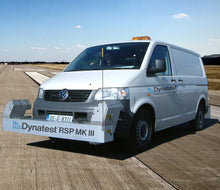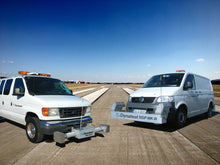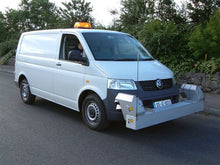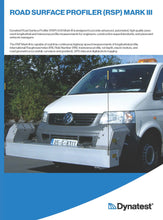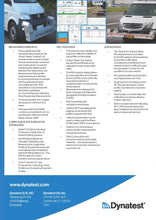
Road Surface Profilometer MK III
The Dynatest Road Surface Profilometer MK III (RSP MK III) is an advanced and automated system designed for precise longitudinal and transverse profile measurements of pavements.
The RSP MK III offers a comprehensive range of measurements and indices, including the longitudinal profile, International Roughness Index (IRI), Ride Number (RN), transverse profile, rutting, macrotexture, and geometrics (crossfall, gradient, and radius of curvature). It also provides data for the calculation of the Boeing Bump Index (BBI). With its unique "Stop & Go" functionality, the RSP MK III operates efficiently in urban areas, allowing data collection at traffic lights, stop signs, junctions, and roundabouts, making it suitable for both urban and rural networks.
This equipment meets stringent standards such as ASTM E950 Class 1, AASHTO R 57, and independently verified State road standards, including Text-1001-s, ensuring high accuracy and repeatability under various conditions. The collected data can be utilised for project and network evaluation, as well as in Pavement Management Systems.
The RSP-III is a fully upgradeable system that can accommodate up to 21 lasers, making it ideal for highways and airports.
For added versatility, the portable RSP-IV version can be easily attached to any vehicle and has the capability to mount 1 or 2 lasers. The RSP-IV is suitable for testing cycle paths to determine the Cycle Profile Index (CPI), highways for IRI and RN measurements, and airports for BBI determination.
Both the RSP-III and RSP-IV offer additional options such as texture-capable lasers, (D)GPS for geo-referencing data in Geographic Information Systems (GIS), and Right Of Way (ROW) cameras.
Key Benefits:
- Rapid screening of roughness across all network sections.
- Geo-referenced data with GPS option for easy integration with GIS systems.
- "Stop and Go" feature enables testing of short sections and urban streets, making it suitable for project-level and network-level data collection and analysis.
- Operates at traffic speed, eliminating the need for expensive traffic management.
- Real-time data collection, analysis, and storage save engineering time during post-processing.
- Texture lasers collect IRI/RN and macrotexture data simultaneously in a single run.
- Automated monitoring of laser readings ensures high data quality.
- Highly accurate, repeatable, and reproducible data suitable for Dynatest's Pavement Management Software (PMS).
- Modular system design facilitates easy maintenance, servicing, and upgrades.
- The Dynatest Data Collection (DDC) Field program provides a step-by-step guide for easy calibration of lasers, accelerometers, and Distance Measuring Instrument (DMI).
- Upgradeability to a Multi-Function Vehicle (MFV) is possible for future expansion.
The Laser sensors
The Dynatest Mark III can have all from 1 to 21 lasers, always with an odd number because there is always one in the center of the beam. The Lasers are going into the Digital Processing Unit (DPU), and the DPU has place for up to 21 lasers.
Three laser types are used in the Dynatest Road Surface Profiler. All three lasers types are extremely rugged and reliable, and considered to be the finest laser sensors available for profiling pavements. The main laser used in the Road Surface Profiler III is an All-In-One 3D displacement sensor, but it is also possible to select up to two texture lasers, which would be placed in the wheel path. If only 1 texture laser is selected, it will be located on the inner wheel path.
- It is also an option to select the angled laser, which will be placed in the top boxes on the wings with 2m long range.
- If required, a line laser could also be selected, which is good for measuring very grooved pavements.
- The Dynatest Mark III RSP can (optionally) be delivered with an Inertial Motion Sensor (IMS) which enables the determination of pavement Crossfall, Grade (longitudinal) and Curve Radius (horizontal).
The special Stop & Go function
The “Stop & Go” feature within the Dynatest Road Surface Profilers allows IRI and RN measurements to be taken at all traffic speeds, allowing testing at junctions, traffic lights, roundabouts and testing of short sections where it is difficult to gain enough speed, or when it is not possible to do a pre-section(tined) concrete.
This function makes it possible to drive under normal circumstances and still avoid a lot of work to cut and connect the measuring data afterwards. This saves time & money and ensures correct datasets. No need for rubber banding and no need for calculating averages.
Without this function it is impossible to test section of pavements less than 150 meter long or areas where speed has to be reduced below 15-20 km/h such as junctions and roundabouts. It has been shown that without “Stop & Go”, the road owner may not be able to collect data on up to 1/3 of the pavement network.
Measurements Parameters (Road Surface Profiler)
Longitudinal Profile, IRI and Ride Number
The longitudinal profile elevation measurements are obtained by using an accelerometer to monitor vertical vehicle body movement, and a laser sensor for measuring the displacement between the vehicle body and the pavement. Road profile elevation measurements are obtained by summing the vehicle body movement with the appropriate body-road displacement. Profile measurements in one or both wheel paths are possible. For the Mark III, if profile elevations are measured in both wheel paths simultaneously, it is also possible to measure profile elevations in the center of the lane, even if only a laser sensor is installed in that position. IRI is calculated in accordance with procedures and specifications outlined in World Bank Technical Paper Number 46 “Guidelines for Conducting and Calibrating Road Roughness Measurements”. Ride Number is calculated using methods outlined in “Measuring & Analysing Road Profiles, National Highway Institute Short Course Manual, University of Michigan, Transportation Research Institute, October 1997”.
Rutting (Mark III only)
With a minimum of five laser sensors, a very simple lane “cross profile” and a simple, separate rut value for each wheel path can be calculated. By adding another two, four, six or more lasers (up to a total of 21), the transverse profile can be defined in greater detail, hence the rutting can be determined more accurately.
Texture
Any or both wheel path laser sensors can be of a texture-capable type employing smaller spot size and higher sampling frequency. For the Mark III the centerline laser sensor can also be texture-capable. The macrotexture statistics reported are in accordance with the established standard ‘Mean Profile Depth’ (MPD) and Root Mean Square (RMS). Both statistics are computed continuously and can be reported as close as every 100 mm (4 inches). Mean Profile Depth is measured according to ASTM E1845-01 “Standard Practice for Calculating Pavement Macrotexture Mean Profile Depth” and ISO/CD 13473-1 “Characterisation of Pavement Texture Utilising Surface Profiles”.
The profiler can also calculate the RMS (Root Mean Square) of the profile trace, which provides additional useful information regarding pavement texture (for further information, see “High-Speed Texture Measurement Of Pavements”, Kevin K. McGhee, P.E., Gerardo W. Flintsch, Ph.D., P.E., Virginia Polytechnic Institute & State University, Virginia Transportation Research Council, February 2003).
Crossfall, Grade, and Radius of Curvature (Mark III only)
By adding an Inertial Motion Sensor (IMS), collection of crossfall, grade, and highway curvature information is possible. The IMS is a microprocessor controlled, self-compensating, three-axis solid-state gyro unit. Crossfall is computed as the slope of a linear regression line through the laser elevation measurements, adjusted for roll information obtained by the gyro. Crossfall is displayed and stored in degrees.
Grade is the longitudinal slope of the lane under test. It is displayed and stored in degrees.
Radius of Curve (km or mile) and Curvature (deg/km or deg/mile) of the lane is determined in the horizontal plane. Turn rate (degrees per second) and the vehicle velocity are the basis for these computations.
Laser Elevations and Accelerations
Raw laser elevation data (height of each laser above the pavement surface) and raw vertical acceleration can be stored at user-specified intervals. Elevations determine the Cross-Profile and are useful for verifying rut measurements or providing data from which to calculate rut depths using alternative procedures.
Faulting
Faulting on jointed concrete pavements can be detected according to “Standard Practice for Estimating Faulting of Concrete Pavements AASHTO Designation: PP39-99”. The RSP field program provides ample flexibility for the user to specify and/or modify the definition of a fault.






